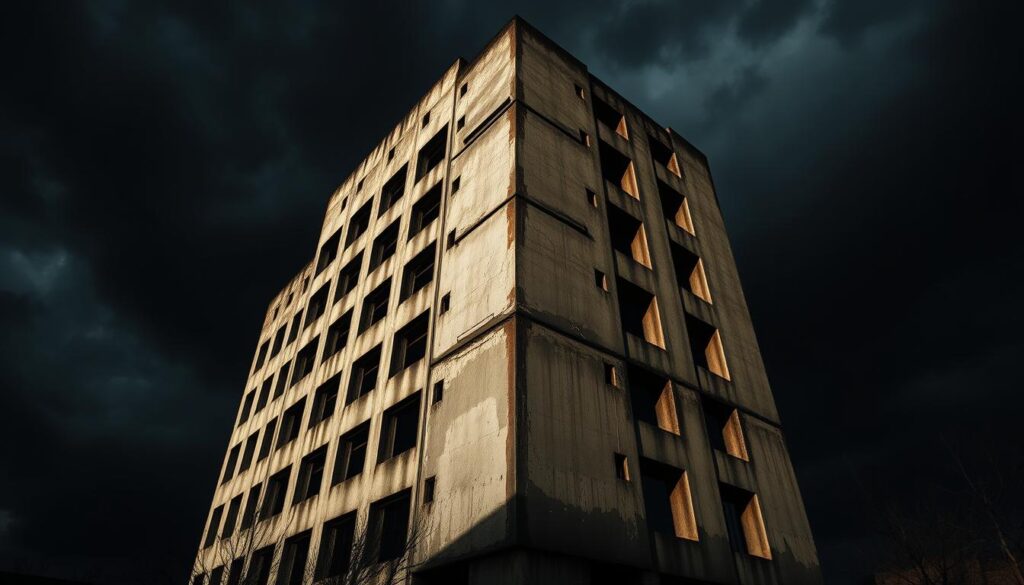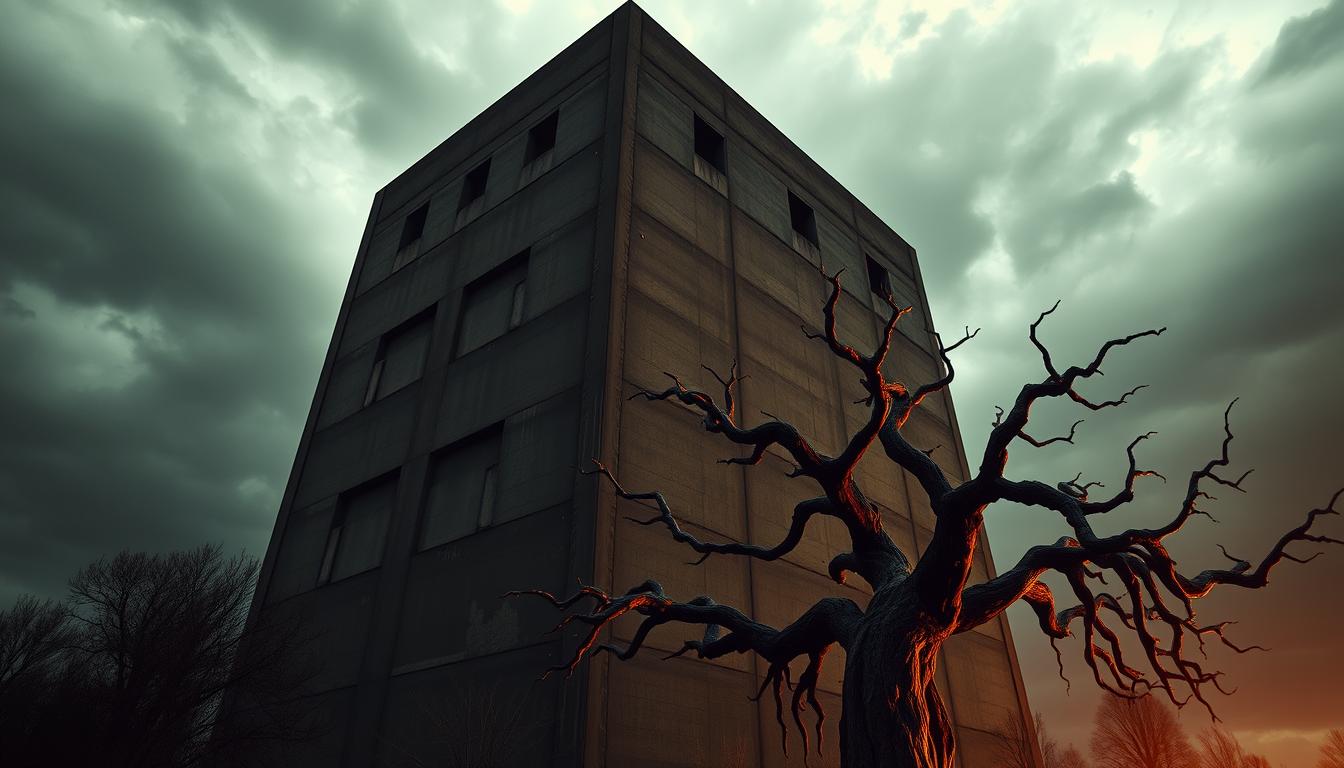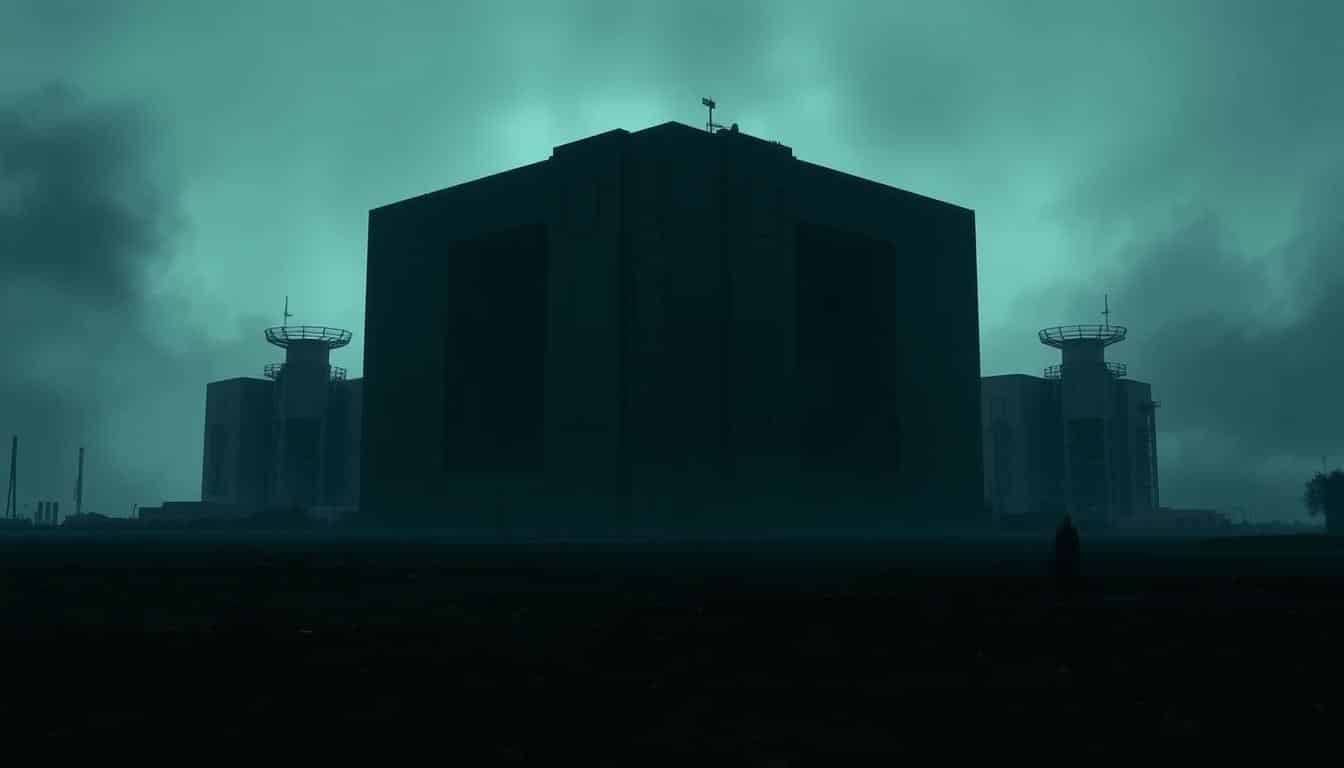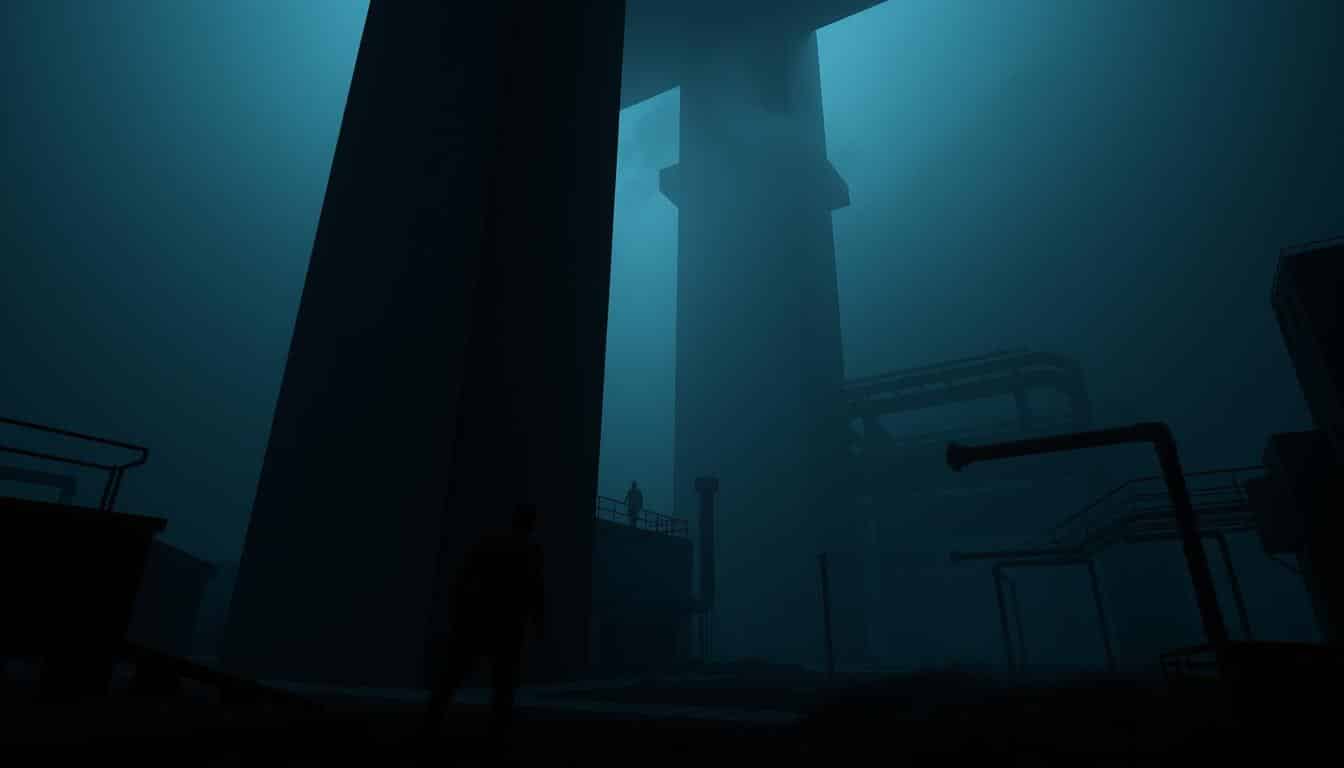In horror games, brutalist architecture’s unique features greatly increase the scare factor. Its raw look brings a sense of discomfort, making the game’s atmosphere more tense. This style and the game’s design work together, affecting how players feel and react.
The big, bold structures of brutalist architecture add to the game’s story, creating a feeling of tension. They make the fear more intense for players.
The link between game design and how players feel is clear. The buildings in the game really impact the story and how tense it feels. Let’s look more at how these design choices change the game experience.
The Impact of Brutalist Architecture on Horror Aesthetics
Brutalism appeared in the mid-20th century with a focus on raw materials and geometric shapes. It boldly shapes the design of horror games. The simple, yet intimidating, look of brutalist buildings creates a perfect setting for spooky video game stories.
Understanding Brutalism in Modern Design
Brutalism is known for putting function first, often showing off strong, striking details. With its use of bare concrete, unusual forms, and big structures, it sparks many feelings. In video games, these designs pull players deeper into the story, making them feel more scared and uneasy.
Common Features of Brutalist Architecture in Gaming
In horror games, brutalist architecture adds to the scare factor in specific ways:
- Untouched textures make places look forgotten and creepy.
- Huge shapes make players feel small and unimportant.
- Unbalanced forms create tension and surprise.
- Wide areas make players feel alone, surrounded by desolation.
These brutalist features make horror games even more thrilling. They match perfectly with the scary stories being told.

Creating Tension through Brutalist Design in Horror Games
Brutalist design uses raw materials and big, imposing structures. It’s key in making horror games tense. The bare and unfriendly nature of brutalist places makes players more anxious. This heaviness in their hearts makes the game feel more intense. The unease these settings create taps into our deepest fears, leading to a strong emotional reaction.
The Emotional Weight of Brutalist Spaces
Brutalist places are often cold and unwelcoming, making you feel alone and heavy. This feeling comes from:
- Big buildings that make players feel small.
- Using concrete to make you feel isolated.
- A simple design that makes everything feel unfamiliar and unsafe.
These aspects work together to make the game tense. Every turn might hide a danger, and every empty space could be scary.
Using Brutalist Elements to Evoke Fear
Adding certain fearful elements to design makes horror games even more unsettling. Strategies include:
- Using very quiet moments to make the player feel more alone.
- Harsh lights that create long, scary shadows, making you unsure of what’s hidden in the darkness.
- Designing tight spaces that can make you feel trapped and claustrophobic.
By mixing these brutalist features, game designers can effectively scare players. They make every part of the game maximize unease. This makes the experience both intense and unforgettable.
The Role of Absence in Brutalist Environment Design
Absence in design greatly affects how we see and feel about horror games. Brutalist settings use the fear of absence to make players uneasy. Their simple and bare looks enhance feelings of discomfort. This leads to a strong feeling of being unsettled by the architecture.
How Absence Creates Unease in Player Experience
Brutalist buildings have large, empty spaces that scare us with their emptiness. These spaces can make players feel alone and exposed. The lack of details makes us wonder what’s missing, increasing the fear. This emptiness, without any cozy features, makes us more aware of the stark settings. It confronts us with a void that heightens the unease.
Architectural Uncanniness and Architectural Elements
Brutalist structures often show elements that feel strange. The use of raw materials and unfinished looks makes us uncomfortable. Things like sharp angles, repetitive textures, and big shapes add to the feeling of emptiness. Sometimes, areas feel deliberately empty, as if something hidden is nearby. These design choices build a strong sense of strangeness fitting for horror games.
The Psychological Effects of Spatial Design in Horror Games
In horror games, the way spaces are designed really matters. It affects how players feel, making things more tense and scary. Designers use the game’s architecture to make players feel more vulnerable and anxious.
Manipulating Spatial Awareness through Design
Designers are super skilled at using space to crank up the tension. They play with distorted spaces and unexpected layouts to confuse players. This not only makes navigating harder but also cranks up the creepiness.
When the game makes you feel trapped or small, it’s doing its job. It’s all about making the horror vibe stronger through the way spaces are designed.
The Concept of ‘Being Watched’ in Game Environments
Feeling like you’re being watched adds a lot to horror games. Designers use tricks to make you feel like someone, or something, is always watching. Things like big windows or mirrors can make players feel spied on.
This trick plays with your mind, making the game even scarier. It’s like the game’s setting is alive, messing with you as you play. It makes the story’s scary parts hit harder.
Integrating Sound Design with Brutalist Aesthetics
Mixing sound design with brutalist looks creates a deep feeling that pulls you in during games. Sounds that unsettle are key to this mix. When playing, the quiet moments can really make the suspense grow. This makes the gameplay more intense.
As gamers move through simple, bold landscapes, the sounds make everything feel more real. They dive deep into a journey full of fear and worry.
The Unsettling Nature of Soundscapes
Horror games use soundscapes to make the brutalist style even more eerie. Background sounds and sudden noises work together to put you on edge. This makes the gamer always look around, feeling a constant chill.
The trick of mixing quiet with loud noises messes with emotions. It makes a feeling of fear that sticks with you.
Case Study: Sound in A24’s The Brutalist and Horror Games
The movie “The Brutalist” by A24 shows how important sound is in scary stories. Sounds in the movie make you feel the same tension as in horror games with similar styles. With echoes and whispers, every scene pulls you in more.
This example proves that sounds mixed with visuals are key to making stories and games more intense. Sound in horror is essential for making things feel tense.
Game Design Techniques for Maximum Tension
Making horror games tense involves clever game design, using brutalist architecture. Having protagonists that players can feel sorry for is key. Their weaknesses stand out against the harsh, concrete surroundings. This setup makes the game’s challenges feel real and scary.
Creating Vulnerable Protagonists in Brutalist Settings
Brutalist settings make characters’ vulnerability more striking. By creating characters who are both physically and mentally weak, players feel for them more. This deep connection makes every scary moment more intense. The cold, hard world makes their journey seem even more daring.
Balancing Gameplay Mechanics with Environmental Design
Combining gameplay mechanics with environmental design is crucial for horror games. Designers must blend game actions with the raw feel of brutalist architecture. Things like limited resources, being stealthy, and solving puzzles make the game better. They increase the sense of danger, making every choice vital. This careful mix keeps players totally into the game, feeling the suspense with every step.
Case Studies of Horror Games Utilizing Brutalist Design
Horror games have been using brutalist design to stand out. This design shapes how players feel and experience the game. It’s not just about looking good. These games use brutalism to make scenes scary and tense. This creates a memorable, eerie game atmosphere.
Analyzing Specific Titles that Embody Brutalist Features
Some horror games really show the power of brutalist design. For instance, “Layers of Fear” and “Hellblade: Senua’s Sacrifice” use simple shapes and raw materials to pull you in. Here are games that use brutalism well:
- “Silent Hill 2” – Its city setting brings feelings of loneliness and despair.
- “Amnesia: The Dark Descent” – Its empty spaces make everything feel scarier.
- “Resident Evil 7” – The left-behind buildings make you feel trapped and worried.
How These Games Create an Eerie Atmosphere
Looking closely at these games shows us something important. The way they mix architecture and sound creates a deep unease. Bright lights and deep shadows make you feel lost. Sounds in the game deepen the scary feeling. This mix makes the game world come alive:
- Game buildings almost feel like they are part of the story, affecting how you play.
- How the game world is shown can make players feel more connected to it.
- The game’s sounds work well with what you see, making everything scarier.
Brutalism vs. Traditional Horror Design Approaches
The design choices in horror games really shape how we feel and stay engaged. When we look at brutalism versus traditional design, we see they both handle horror differently. Brutalism, in particular, hits hard for those wanting a deep horror vibe.
Comparative Analysis of Architectural Styles in Horror Games
Traditional horror leans on gothic looks, using detailed, moody lighting to make us feel scared. But brutalism? It’s all about raw concrete, straight lines, and feeling small against something huge. These two styles make us react in their own ways. Traditional styles might make us feel a spooky sense of the past, but brutalism can make us feel alone and scared.
- Traditional design often utilizes soft shapes and intricate details, creating a comforting but eerie atmosphere.
- Brutalist structures, with their harsh materials and imposing forms, provoke a sense of existential dread.
- The clear contrast between warmth and coldness stimulates varying degrees of player anxiety.
Why Brutalism Works for Horror Themes
Brutalism gets to us because it’s all about being real, and sometimes, that’s scary. It makes horror feel more intense by stripping down to the basics. It’s the simplicity and bareness of brutalism that pull us in. We start to really think about where we are, making the game even more tense and scary.
- Brutalism serves as a metaphor for the struggle against oppressive environments.
- The absence of traditional embellishments allows for more focus on narrative and emotional impact.
- Players may find themselves reflecting on their vulnerabilities in relation to the oppressive structures around them.
Future Trends: Brutalist Design in Upcoming Horror Games
The future of brutalism in gaming is full of exciting possibilities. Developers are finding new ways to mix technology and design to change horror landscapes. They use the latest tools and simple architectural styles to create new gameplay experiences. As horror game looks change, creators are adding these new design trends. They aim for immersive settings that make players feel strong emotions.
Emerging Technology Influencing Design Choices
Game development technology is changing brutalism in horror games. Things like real-time rendering, augmented reality, and machine learning are key. They help make game environments feel more real. These tech advances let developers:
- Boost visual details with better textures and lighting.
- Make player interactions with the game world more lively.
- Use player data to make horror that feels personalized.
The Evolution of Horror Game Aesthetics
Horror game design is moving away from old styles. Brutalism’s stark and bold structures make games feel more tense. This pushes the genre to new limits. Developers are blending brutalism in new ways, making games that:
- Use environment stories to show fear in abstract ways.
- Focus on how spaces are designed to make players feel alone.
- Combine sound and architecture to make creepy vibes.
This design shift follows new trends and makes games scarier in fresh ways. It keeps brutalist looks important in horror games.
Conclusion
This article showed how brutalist design deeply influences horror game tension. It talked about the style’s stark aesthetics and how they create a sense of dread. These elements make players feel uncertain and scared.
We looked at how architecture does more than set the scene in horror games. It affects how players act and react. This is key to making the games truly scary.
Our exploration into game design showed many factors build up the tension. This includes the lack of certain elements, soundscapes, and how spaces are designed. These methods make the emotional impact stronger. They weave a complex feeling of unease.
Horror games are always evolving, making them more engaging. The use of brutalist architecture keeps these games scary and interesting. This ensures they stay important in the gaming world.
As developers use these design ideas, we can expect games filled with tension and great stories. This will keep players hooked and wanting more.



